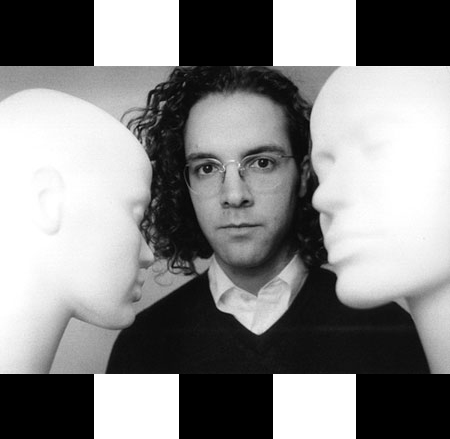|
The Bare
Minimum: |
|
Vital Statistics:
Born: Baltimore, MD. May 3rd, 1969. Company: Family-Owned Small Business. Lauded for: Impeccable, minimal dresses utilizing couture draping in luxury fabrics and cashmere. The Key: Wonderful styling through the use of one seam for each dress. Stores: Neiman Marcus and Bergdorf Goodman. Retail Price Points:$1500 - $4000. |
|
|
Von Ziggy went behind the seams and spoke to the young designer about his inspiration and direction, and even tried one on. She left impressed with William Calvert's honesty and ingenuity, and most of all, by how flattering his dresses really are. Von Zig for FI: Everything is made to order and not ready-to-wear? W: Yes, everything is made to measure. FI: I describe your work as minimal and chic. It's often called couture. What makes it couture? W: Couture actually means "made to measure", but in America we bastardize that term to mean more expensive than designer. Donna and Calvin are designer product, but firms like Geoffrey Beene and Carolina Herrera who are a bit more expensive are considered a couture product. We bring a "made to measure" quality to the store and individuals. FI: In couture terms, does that mean you can wear your dresses inside out? W: No one has ever done that yet, but I would like to think they could. FI: How did you find working at Balenciaga? I had a draping professor at FIT who would ask: "Who is the master tailor?" and before we could answer, he would always screech, "Balenciaga! Balenciaga! Balenciaga!" W: It was great working at Balenciaga. Michel Goma, the head designer, is very talented. He does Balenciaga by mixing past, present and future styling. Most people think of Balenciaga as austere and severe. I found it severe in a flamenco sort of way - not in a Jil Sander way. It was wonderful to experience the quality of the workmanship. The (European) approach is very different from America where they just stitch things up here and there and it's "done"; I don't want to do that, I want to make pretty clothes, and pretty clothes cost. To make them fit well and hang well, you have to use really special fabric. That's tricky. FI: Who do you think your customer is? W: Someone who likes and understands fashion - size 4 to 12 - short or tall - who wears jewelry and a dress but not dresses with jewelry on them - I don't do bells and whistles. I went to the Galliano party at Bergdorf's last night. I have the greatest respect for him because he's been a great influence on fashion. What he does is fantastic - but it's Baroque- I would get lost sticking all that stuff on one dress. FI: So how did you arrive at the conclusion that you wanted to be a designer. I read somewhere that you couldn't find anything to wear in Baltimore and... W: ...and I walked out of the house one day naked. (We both laugh). It's funny because I think in a lot of ways design chose me. As a kid, I painted on the walls and sculpted whatever I could lay my hands on, and was always really fascinated by what people wear. I think that people kid themselves when they wake up in the morning and dress themselves that say they're not making a statement. Whether they're wearing a 3 piece Brooks Brothers suit and sneakers or Armani or Moschino or Galliano - they're making a big statement everyday. FI: What is your main inspiration? W: I am influenced by what I see in the world, but I don't want to appropriate other designers' details. So many American sportswear companies do that - and enough already! I think that houses like Prada, for example, are successful because they have their own undiluted look. FI: Speaking of diluted - on my walk from the subway to your office here on 57th street - I noticed the new Strawberry's. There's a need for that - it's not what we want because it's definitely not about fashion - it's about something else entirely. How do you feel about the growth of these businesses in relationship to yours? W: It's strange. I think that a rift has formed and either you can afford fashion per se or you can't. Fashion and clothing have become two different things and certainly there are people with great style who can make fashion out of mere clothing, but if you want fashion you have go to spend a bundle of money - which is both understandable and a total shame. A $1000 suit is not affordable, when there's something durable and wearable at Bolton's. (Also on this block - also owned by Strawberry's.) Why can't fashion be delivered at cheaper price points? FI: What are you thinking about for yourself in the future? W: At this point I'm thinking about how many more people I need to hire to branch into daywear - or evening suits - because right now I'm just doing dresses. At this point I'd like to expand the business horizontally. I'd love to have my own production facilities and do the designer line and a moderate line all the way down to Kmart... day suits and shoes. We'll see what the market brings. Maybe I'll have to do a cheaper line called W.C...like water closet.. I don't know. FI: Your collection is minimal - sleek - bare - clean. But how flattering are your colors? W: So often purists do these collections that are so icy. Minimal should not be icy, it should be clean and warm. Steely gray cashmere has that nesting feeling when you touch it. Black is the only color absolutely anybody can wear. Navy adds sophistication. I like gray (Vogue quote) because a lot of precious things are gray... black pearls.. platinum...I try to use friendly shades. I like wearable colors like stone - it's casual, but you always look dressed. FI: You have referred to your dress construction studio as a laboratory. Please elaborate. W: What we do here is experiment. We're not about making a dum-dum dress every time that can fit anybody. At this price point you must maintain your originality through experimentation. Rather than adding surface detail, the detail in my dresses come from how they're made. Draping designs the whole dress rather than just adding detail. I try to get a lean line that's based on function rather than frivolity. Like this jacket with a harness that supports it - on the hanger it just looks like an interesting detail, but on the body, the harness is a built-in bra. FI: How does the one seam technique make the dresses more beautiful or flattering for you? W: It's one of my favorite design parameters. How can I make a dress out of just one piece of cool fabric? When I first started making dresses with one seam, I assumed they'd fit like regular dresses, but they have a completely different balance. Like the car commercial touting body parts stamped out of the same piece of steel so they fit together better. The whole thing hangs like one piece should, rather than pieces stuck together. It fits more like a bodysuit than a bodysuit does - and more like a second skin - because there are no seams. ©Fashion Icon 1997 |
 |
 |
 |
 |
 |
